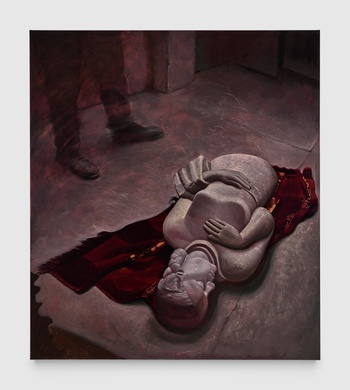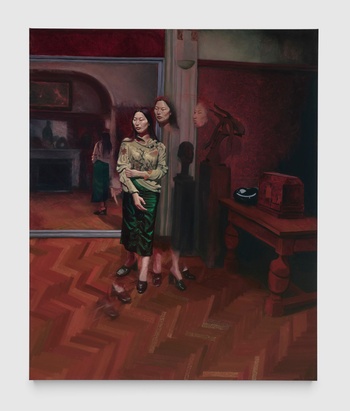He just turned thirty and he’s already internationally recognised: Bendt Eyckermans (1994) is crafting an impressive oeuvre where his family history, Belgian painting, and personal observations converge.

©
WeDocumentArt
| Bendt Eyckermans Virtual displacement, 2024 Courtesy of the artist and Mendes Wood DM, Sao Paulo, Brussels, Paris, New York
He just turned thirty and he’s already internationally recognised: Bendt Eyckermans (1994) is crafting an impressive oeuvre where his family history, Belgian painting, and personal observations converge.
His creative talent is in his genes. Eyckermans descends from a long line of visual artists. He grew up surrounded by the sculptures of his grandfather Lode and his father Barthold. His Antwerp studio, where he paints, has belonged to the family for decades and is still filled with sculptures made by his forefathers.
Inspired by Belgian masters like Bruegel, Rubens, Spilliaert, and Permeke, Eyckermans opted for painting at the Antwerp Royal Academy of Fine Arts, rather than sculpture like his father and grandfather. It was there that gallerist and art dealer Sofie Van de Velde first encountered his work. “It was immediately obvious that he stood out from all the other art students. His ancestors were sculptors, and you notice that he has captured that within his frame of reference, consciously or unconsciously. He can clearly build on elements absorbed from his background. I found that sublime straight away, really,” she said to Flemish newspaper De Morgen.

©
WeDocumentArt
| Bendt Eyckermans, Emblems lost, 2025 Courtesy of the artist and Mendes Wood DM, Sao Paulo, Brussels, Paris, New York
Eyckermans depicts small, everyday scenes in a highly dramatised, almost cinematic way. He draws inspiration from his immediate surroundings and a deep appreciation for Belgian art history. Yet his style remains entirely his own: he doesn’t want to copy, but to create his own visual language.
His paintings bear a sculptural quality. Not only because of the sculptures that often appear on his canvases, but also thanks to his painting technique which gives his works the feel of a bas-relief. Over dark layers of paint, he applies thick, light layers that seem to emerge from the flat surface.
Friends and family serve as models, with their informal poses carefully staged to suggest something just outside the frame: something dark and ominous. “Cheerful artworks aren’t that interesting,” Eyckermans once told De Morgen, “troubled villains are always more compelling than decent people.”

©
WeDocumentArt
| Bendt Eyckermans, Voices, 2025 Courtesy of the artist and Mendes Wood DM, Sao Paulo, Brussels, Paris, New York
His scenes feel familiar, yet are filled with an unsettling undercurrent. Everyday moments become fertile ground for symbolism. The scenery is steeped in surrealism and mystery. Eyckermans isn’t looking for a narrative. He wants to create visual poetry. Shocking people or making the world a better place isn’t the goal. He wants to capture his own transience, and that of those around him, with paint. In order to achieve this, he bases his work on photographs. He always keeps a camera handy to capture moments. He processes the photos into a collage, and the collage becomes a painting where perspective and reality are distorted. Figures often appear mid-movement, frozen in action. For the series currently showing at Mendes Wood DM, he takes things a step further: the paintings resemble photographic sequences. Movement is made visible through ghostly apparitions, after-images of a movement that has passed or is yet to come.
The international demand for his work is growing. Producing fifteen to twenty large canvases a year, Eyckermans works slowly, resulting in a waiting list, and always more collectors eagerly awaiting new pieces. The young painter himself isn’t losing sleep over it. Eyckermans: “What people see in a work says more about them than it does about me.”

©
WeDocumentArt
| Bendt Eyckermans, The mirror, 2024 Courtesy of the artist and Mendes Wood DM, Sao Paulo, Brussels, Paris, New York